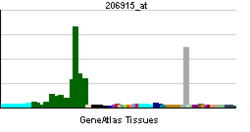NKX2-2
Homeobox protein Nkx-2.2 is a protein that in humans is encoded by the NKX2-2 gene.[1][2][3]
Homeobox protein Nkx-2.2 contains a homeobox domain and may be involved in the morphogenesis of the central nervous system. This gene is found on chromosome 20 near NKX2-4, and these two genes appear to be duplicated on chromosome 14 in the form of TITF1 and NKX2-8. The encoded protein is likely to be a nuclear transcription factor.[3]
The expression of Nkx2-2 is regulated by an antisense RNA called Nkx2-2as.[4]
References
- ↑ Furuta H, Horikawa Y, Iwasaki N, Hara M, Sussel L, Le Beau MM, Davis EM, Ogata M, Iwamoto Y, German MS, Bell GI (Sep 1998). "Beta-cell transcription factors and diabetes: mutations in the coding region of the BETA2/NeuroD1 (NEUROD1) and Nkx2.2 (NKX2B) genes are not associated with maturity-onset diabetes of the young in Japanese". Diabetes 47 (8): 1356–8. doi:10.2337/diabetes.47.8.1356. PMID 9703340.
- ↑ Price M, Lazzaro D, Pohl T, Mattei MG, Ruther U, Olivo JC, Duboule D, Di Lauro R (Mar 1992). "Regional expression of the homeobox gene Nkx-2.2 in the developing mammalian forebrain". Neuron 8 (2): 241–55. doi:10.1016/0896-6273(92)90291-K. PMID 1346742.
- ↑ 3.0 3.1 "Entrez Gene: NKX2-2 NK2 transcription factor related, locus 2 (Drosophila)".
- ↑ Tochitani S, Hayashizaki Y (August 2008). "Nkx2.2 antisense RNA overexpression enhanced oligodendrocytic differentiation". Biochem. Biophys. Res. Commun. 372 (4): 691–6. doi:10.1016/j.bbrc.2008.05.127. PMID 18538132.
External links
Further reading
- Hessabi B, Schmidt I, Walther R (2000). "The homeodomain of Nkx2.2 carries two cooperatively acting nuclear localization signals.". Biochem. Biophys. Res. Commun. 270 (3): 695–700. doi:10.1006/bbrc.2000.2491. PMID 10772886.
- Wang CC, Brodnicki T, Copeland NG et al. (2000). "Conserved linkage of NK-2 homeobox gene pairs Nkx2-2/2-4 and Nkx2-1/2-9 in mammals.". Mamm. Genome 11 (6): 466–8. doi:10.1007/s003350010089. PMID 10818213.
- Deloukas P, Matthews LH, Ashurst J et al. (2002). "The DNA sequence and comparative analysis of human chromosome 20.". Nature 414 (6866): 865–71. doi:10.1038/414865a. PMID 11780052.
- Strausberg RL, Feingold EA, Grouse LH et al. (2003). "Generation and initial analysis of more than 15,000 full-length human and mouse cDNA sequences.". Proc. Natl. Acad. Sci. U.S.A. 99 (26): 16899–903. doi:10.1073/pnas.242603899. PMC 139241. PMID 12477932.
- Sun T, Dong H, Wu L et al. (2003). "Cross-repressive interaction of the Olig2 and Nkx2.2 transcription factors in developing neural tube associated with formation of a specific physical complex.". J. Neurosci. 23 (29): 9547–56. PMID 14573534.
- Gerhard DS, Wagner L, Feingold EA et al. (2004). "The status, quality, and expansion of the NIH full-length cDNA project: the Mammalian Gene Collection (MGC).". Genome Res. 14 (10B): 2121–7. doi:10.1101/gr.2596504. PMC 528928. PMID 15489334.
- Smith R, Owen LA, Trem DJ et al. (2006). "Expression profiling of EWS/FLI identifies NKX2.2 as a critical target gene in Ewing's sarcoma.". Cancer Cell 9 (5): 405–16. doi:10.1016/j.ccr.2006.04.004. PMID 16697960.
- Pauls S, Zecchin E, Tiso N et al. (2007). "Function and regulation of zebrafish nkx2.2a during development of pancreatic islet and ducts.". Dev. Biol. 304 (2): 875–90. doi:10.1016/j.ydbio.2007.01.024. PMID 17335795.
This article incorporates text from the United States National Library of Medicine, which is in the public domain.
| ||||||||||||||||||||||||||||||||||||||||||||||||||||||||||||||||||||||||||||||||||||||||||||||||||||||||||||||||||||||||||||||||||||||||||||||||||||||||||||||||||||||||||||||||||||||||||||||||||||||||||||||
